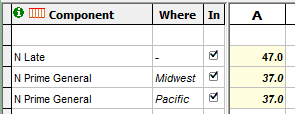Different Plans for Different Areas
Some plans may specify different weights in different areas. For example, we might plan for the top 5 markets, but with a separate allocation of weight in each. Or, we might have a national plan with a heavy-up in a region, such as the east coast, or certain markets.

We cannot just use demos to define these areas, because we need to control how different areas have different ad placements.
To handle multiple areas, we use TView's "Where" column, described in the next topic. But first, let's think about how this works.
Understanding How This Works
Suppose I advertise on WABC-TV, the ABC affiliate in New York, to heavy-up on Women 25-54 in New York.
Here are some typical questions we might get about that:
| • | Is "New York" part of a demo? |
| • | How do I tell TView that I only want ABC in New York? |
| • | I want to place 100 GRPs, but how do I say that this is 100 GRPs in New York only? |
To really understand how to look at questions like these, we need to appreciate how cool it is to work with respondent-level data. (For a description of what respondent data is, see the section on How TView Works.)
Here is a sample of how respondent-level data might report the cumulative audience to some networks:
Name* |
Age |
Market |
ABC |
CBS |
Discovery Channel |
National Geographic Channel |
|---|---|---|---|---|---|---|
Alice |
64 |
Billings |
Yes |
No |
Yes |
No |
Barbara |
43 |
New York |
Yes |
Yes |
No |
Yes |
Carlyn |
13 |
New York |
No |
Yes |
Yes |
Yes |
Dave |
47 |
Chicago |
Yes |
No |
No |
No |
Earl |
34 |
Altoona |
No |
Yes |
No |
Yes |
Frances |
26 |
New York |
Yes |
Yes |
Yes |
No |
Gail |
42 |
Philadelphia |
Yes |
Yes |
No |
No |
Helen |
33 |
Houston |
No |
Yes |
Yes |
Yes |
* No, the data we get doesn't actually have people's names in it, though that would be fun!
In respondent data, defining a demographic is as simple as picking the people we're interested in. So, if you want to look at viewing by women from 25 to 54, you would just pick Barbara, Frances, Gail and Helen and call that your demo. Now suppose you wanted to report the viewing done by women 25 to 54 in New York, you'd start your demo with just Barbara and Frances. Defining a demo with a market is made possible in TView in the demo dialog, and you can read about that in the topic Define Your Demographics.
It makes sense that a demo is just a collection of people. Things get more interesting when we think about local market media options.
For example, suppose we want to study the prime-time audience to ABC in New York (which is mostly delivered by WABC, the local affiliate there). We can't analyze this directly in the U.S. Nielsen Mid-Minute or All-Minute data, because WABC isn't reported directly in those sources. But because these are respondent-level sources, and because we have lots of the descriptive data of the respondents, we can pull out just the audience that interests us. If we want to know what ABC delivers in New York, we look at Barbara, Carlyn and Frances. This is exactly what we are doing when we use the "Where" column. Go to the next topic, Where: Restricting a Vehicle to a Specific Area.
